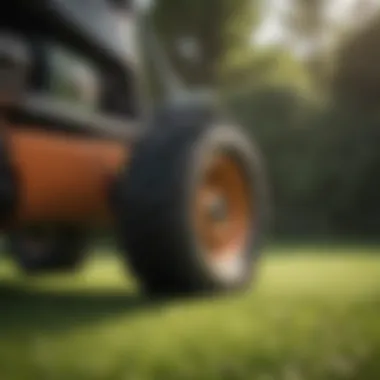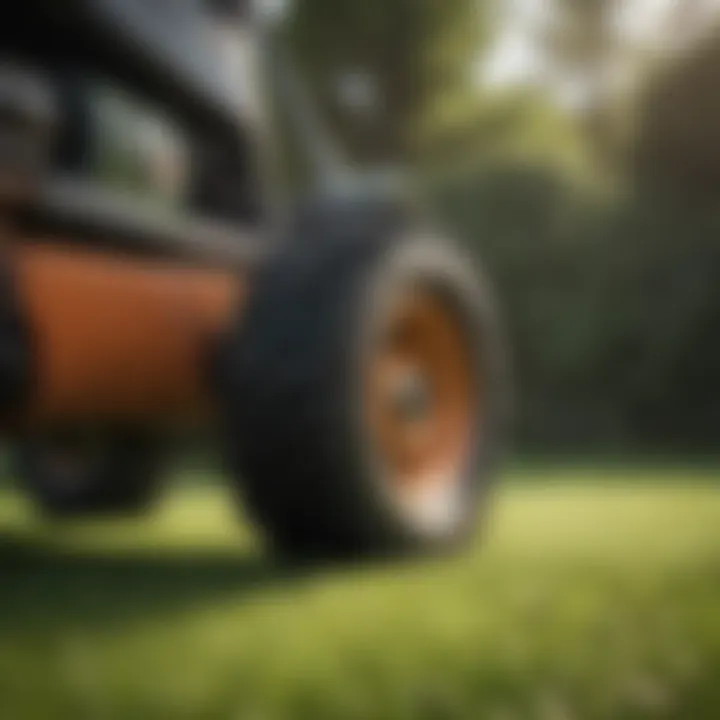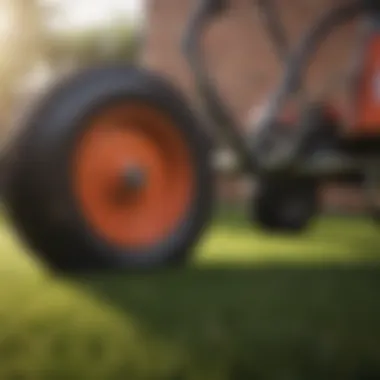Understanding the Rugged Lawn Roller for Maintenance


Intro
In the realm of home improvement, maintaining a lush and healthy lawn is a significant concern for homeowners. Rugged lawn rollers serve as a vital tool in this endeavor. These devices aid in the compaction of soil, which leads to a smoother and more uniform lawn surface. The importance of using a lawn roller is highlighted by its ability to promote healthy grass growth by improving soil contact with the roots.
A well-maintained lawn not only enhances the visual appeal of a property but also adds to its overall value. A transition from patchy grass to a well-groomed yard can be achieved with the correct application of lawn rollers. Understanding the implications of their use and selecting the right type for your specific lawn will ultimately contribute to more effective lawn management.
Preamble to Rugged Lawn Rollers
Rugged lawn rollers serve a vital function in maintaining the appearance and health of lawns. These tools, designed for durability and efficiency, play a significant role in various lawn care techniques. Their importance stems from their ability to compact the soil, thus promoting better grass growth while reducing air pockets. The process ensures even moisture distribution and enhanced seed-to-soil contact, which is crucial for effective germination and root establishment.
Definition and Purpose
A rugged lawn roller is a heavy-duty piece of equipment utilized in lawn care. Primarily, it is a cylindrical tool, often filled with water or sand for weight, that is rolled across the surface of the lawn. The main purpose is to flatten the soil, making it ideal for sowing grass seeds or repairing uneven ground. The weight of the roller applies necessary pressure to the soil, helping to compact it gently without causing damage to the underlying structure. This compaction is essential for establishing strong and healthy turf, providing a solid foundation for grass roots.
Common Uses in Lawn Care
Rugged lawn rollers are multifaceted tools with several common uses that enhance both functionality and aesthetics of outdoor spaces.
- Preparation for Seeding: Before planting grass seeds, using a lawn roller helps to create a firm seedbed. This is especially useful in areas where the soil is loose or has air pockets.
- Post-Seeding Care: After sowing seeds, a roller helps press the seeds into the soil, ensuring they make good contact with the earth, promoting better germination rates.
- Leveling Uneven Ground: If a lawn has bumps or depressions, a lawn roller can rectify these issues, giving it a smoother and more appealing surface.
- Aeration Process: For lawns that are heavily compacted, rolling can help reduce soil compaction, improving water infiltration and root growth.
These varied uses demonstrate the versatility of rugged lawn rollers, making them essential for homeowners who prioritize lawn health and aesthetics. Regular maintenance practices, such as rolling, contribute to lush, vibrant lawns that enhance property appeal.
Types of Rugged Lawn Rollers
Understanding the different types of rugged lawn rollers is crucial for any homeowner looking to maintain a lush and healthy lawn. Each type offers specific features and benefits suited to various lawn conditions. Selecting the right one can significantly impact the efficiency and outcome of your lawn care routine.
Steel Lawn Rollers
Steel lawn rollers are prized for their weight and durability. Constructed from heavy-duty steel, they provide the necessary mass to compact soil effectively. This makes them ideal for leveling uneven ground and packing down newly seeded areas. The rolling action of a steel roller encourages better seed-to-soil contact, which is vital for seed germination.
One of the main advantages of a steel lawn roller is its longevity. A well-made steel roller can withstand harsh weather conditions and prolonged use without sustaining damage. Homeowners may find that although they require a bit more energy to maneuver due to their weight, the efficiency they offer can offset this. Instead of repeated passes over the same area with a lighter roller, a steel model can accomplish the task in fewer rounds.
Poly Lawn Rollers
Poly lawn rollers are a lighter alternative to steel models. Made from high-density polyethylene, they are easy to handle and can be filled with water or sand for weight adjustment. This flexibility makes them particularly appealing to those who prefer a more manageable tool for their lawn maintenance tasks.
One distinct advantage of poly lawn rollers is their resistance to rust and corrosion. This quality is especially important for users living in humid or wet conditions. Additionally, the smooth surface of a poly roller helps to reduce the likelihood of grass clippings sticking during use, making clean up easier.
However, while they may lack some of the robust compaction ability of steel rollers, poly rollers are perfect for smaller yards or lighter rolling tasks. Users often praise them for their ease of storage. When empty, they can be stored in tight spaces without the weight becoming an issue.
Tow-Behind Lawn Rollers
Tow-behind lawn rollers offer a unique advantage for homeowners with larger properties. These rollers are designed to be attached to riding mowers or lawn tractors, allowing for efficient coverage of expansive areas. The convenience of towing a roller behind a mower saves time and energy, making lawn rolling a less labor-intensive task.
Tow-behind rollers come in both steel and poly options, which means users can still choose the material that best suits their needs. The ability to cover more ground efficiently also makes these rollers great for large-scale lawn projects, such as after reseeding or sod installation.
Despite the advantages, there are considerations when using a tow-behind roller. Users need to ensure their mower or tractor is capable of towing the added weight, especially if it is a steel roller. Proper maintenance of both the towing vehicle and the roller itself is essential to ensure safe operation and longevity.
Key Features to Consider
When selecting a rugged lawn roller, it is essential to focus on various key features that can greatly influence both performance and user satisfaction. Understanding these features helps ensure that the investment made will meet specific lawn care needs effectively. Below is a deeper look into the specific considerations that should not be overlooked.
Weight and Material
The weight and material of the lawn roller are crucial elements to consider. Rollers come in different materials, such as steel and poly, each with distinct advantages.
Steel Lawn Rollers:
These rollers are generally heavier and provide a more consistent ground pressure, making them ideal for firms landscapes or compacting soil. However, their weight can make them difficult to handle for some users.
Poly Lawn Rollers:
These are lighter and thus easier to maneuver. They often resist rust and corrosion, which can be beneficial for those living in humid climates. One must balance the weight based on the terrain and ease of transport. A heavier roller might compact soil more effectively, while a lighter model could be easier for smaller yards or slightly uneven areas.
Size and Dimensions
The size and dimensions of the lawn roller play a significant role in its usability and effectiveness. Generally, the width of a roller affects how much area can be covered in a single pass. Wider models can save time but might be challenging to handle in smaller spaces. On the other hand, narrower models provide better maneuverability but require more passes to complete the task.


Consider the dimensions not only in terms of its width but also its height and total length. Ensure it fits comfortably within the storage space available at home. If space is limited, a foldable or more compact design will be beneficial. Knowing the dimensions beforehand can prevent the frustration of purchasing an unsuitable product that won't work for your specific lawn.
Handle Design and Ease of Use
The handle design of a lawn roller greatly contributes to user experience during operation. Ergonomic handles that allow for a good grip can reduce fatigue during prolonged use. Look for adjustable handle options to fit various user heights and comfort levels.
Additionally, a roller's maneuverability should not be ignored. For instance, some rollers come equipped with wheels that enhance portability, while others rely solely on their weight without such features. Ensure that whichever model selected allows for easy push and movement across the terrain.
The overall design can significantly affect how enjoyable the task of lawn rolling can be, especially when managing larger yards or during extensive projects.
Choosing the right lawn roller not only enhances the effectiveness of your lawn maintenance but can also significantly ease the physical burden of the task.
Benefits of Using Rugged Lawn Rollers
Using rugged lawn rollers offers multiple advantages for lawn care enthusiasts. Understanding these benefits can help homeowners and housewives make informed decisions regarding their lawn maintenance strategies. Effective use of these tools contributes to a healthier, more aesthetically pleasing lawn while also streamlining the upkeep process. The following sections detail specific benefits that these rollers provide.
Improved Lawn Health
Rugged lawn rollers play a significant role in enhancing the overall health of the lawn. They help level the ground, which leads to an even distribution of water and nutrients. When the soil is compacted correctly, it promotes better root growth by ensuring that the grass receives sufficient aeration. The compressing action encourages soil particles to form better structure, which also assists in reducing erosion. Additionally, when grass blades are flattened during rolling, it can lead to improved sunlight absorption, which is crucial for photosynthesis.
"Regular use of lawn rollers can dramatically enhance the growth patterns of grass, leading to a thick, luscious lawn."
Enhanced Aesthetic Appeal
The visual quality of a lawn greatly impacts the overall appearance of a home. A well-rolled and maintained lawn appears more uniform and lush. Rolling the lawn allows for reduced bumps and depressions, which can detract from the beauty of the landscape. Furthermore, a level yard will support even growth patterns, giving the grass a fuller look. Rugged lawn rollers can also aid in the recovery process after overseeding or sodding, allowing the new grass to blend seamlessly with the existing lawn. Overall, enhanced aesthetics contribute significantly to property value and can be a source of pride for homeowners.
Efficient Maintenance Practices
Maintaining a lawn can be labor-intensive, but using rugged lawn rollers can simplify the process. The use of these tools reduces the need for extensive manual labor when it comes to achieving a level lawn. Incorporating rolling into the routine helps to consolidate the soil without excessive strain on the user. This method can also be seamlessly integrated with other maintenance tasks such as dethatching or aerating. Moreover, having a sturdy roller helps save time and effort over the long term, promoting a more enjoyable and rewarding lawn care experience.
How to Use a Rugged Lawn Roller
Using a rugged lawn roller effectively transforms the lawn maintenance experience. Correct usage enhances lawn health and aesthetics while reducing future maintenance needs. Knowing how to operate a lawn roller is essential for homeowners aiming to achieve optimal results.
Preparation Before Rolling
Before starting, adequate preparation is key. First, assess the condition of your lawn. Ensure the grass is dry, ideally a couple of days post-mow. Wet grass can lead to uneven rolling and potential damage to the lawn.
Next, examine the lawn roller itself. Check for any damage or wear which could affect its performance. Proper inspection prevents accidents and unnecessary downtime during your lawn care session.
Important points to remember include:
- Clear the area: Remove stones, twigs, or debris from the lawn. This action prevents the roller from collecting unwanted materials.
- Check for sharp edges: Ensure there are no protruding objects that could damage either the roller or your lawn.
- Water the lawn (if necessary): For compacted soils, moistening the lawn lightly can aid in better results. However, avoid saturated conditions.
Proper Technique for Rolling
Once everything is in place, employ the proper technique when rolling. Begin by positioning the lawn roller at one corner of your yard, and then move in straight lines. Avoid circular motions; they can cause uneven pressure on the grass.
While pushing, maintain a consistent speed. Going too slow may not achieve the desired compactness, while rushing can lead to damage or uneven results. It’s also crucial to overlap your paths slightly. This ensures complete coverage and avoids unrolled patches.
Important actions include:
- Change directions: Rotate the roller after completing the initial pass. This technique allows even distribution of weight.
- Listen to the lawn: Pay attention to how the grass responds. If it appears to be flattening excessively, take a break.
Post-Rolling Care
After rolling, care considerations are vital. First, inspect your lawn for any signs of distress. Look for areas that might have been pressed too hard. If you see any damage, address it promptly.
Next, take care of your lawn roller. Clean any dirt or debris from the surface. This maintenance prolongs the life of your roller and prepares it for future use. Lubricate any moving parts as needed to prevent rust and ensure smooth operations.
Finally, evaluate the overall effectiveness of your efforts. Adjust your practices in the future based on your observations today. Long-term maintenance will result in a healthier, more resilient lawn.
"Proper use of a lawn roller not only improves aesthetics but also promotes a healthier lawn over time."


By understanding how to prepare, operate, and care for a rugged lawn roller, homeowners can maximize their lawn's potential while enjoying the beautification of their outdoor space.
Maintaining Your Lawn Roller
Maintaining your lawn roller is crucial for ensuring its longevity and efficiency. A well-maintained roller can provide significant benefits for lawn care, helping to keep your lawn healthy and visually appealing. Proper maintenance reduces the risk of damage and enhances the performance of the roller, making it an essential part of your gardening routine. Ignoring maintenance can lead to costly repairs or replacements in the long run. Here are some key practices to keep in mind:
Cleaning Your Roller
Cleaning your lawn roller regularly is vital. Grass clippings, dirt, and debris can accumulate on the surface after use, impacting its functionality. After each use, make it a point to:
- Remove debris: Use a soft brush or cloth to wipe the roller's surface.
- Rinse with water: For stubborn dirt, rinse the roller with a hose. Avoid using high pressure as it may cause damage.
- Dry thoroughly: Ensure the roller is completely dry before storing it to prevent rust.
This simple yet effective cleaning routine will help maintain the roller's performance and extend its lifespan.
Routine Inspections
Conducting routine inspections is another important aspect of maintenance. Check for:
- Damages: Look for dents, scratches, or any signs of wear and tear.
- Wheels and Bearings: Inspect them for any signs of damage or unusual noise during operation.
- Connections: Ensure that all bolts and connections are tight and secure.
By performing these inspections regularly, you can catch any issues before they become serious problems. Address minor repairs swiftly to keep your roller in optimal condition and reduce the risk of further damage.
Storage Recommendations
Proper storage extends the life of your lawn roller. Consider the following storage tips:
- Dry location: Store the roller in a cool, dry place away from excessive moisture.
- Protective covering: If storing outdoors, use a tarp or cover to protect it from rain and sun.
- Position: Store the roller upright if possible to prevent it from becoming misshapen.
Following these storage tips will ensure that your lawn roller remains reliable and in good working condition when you need it again.
Keeping your lawn roller clean and well-maintained will not only improve its performance but also provide you with a more beautiful and healthier lawn.
Impact on Different Lawn Types
Rugged lawn rollers are not one-size-fits-all tools. Their effectiveness can vary significantly depending on the type of soil in your garden. Understanding the impact of these rollers on different lawn types is crucial for optimal lawn maintenance and aesthetic appeal. Each soil type has unique characteristics that influence how well a lawn roller can perform.
Utilizing a lawn roller correctly means knowing your lawn's needs. This helps in achieving a vibrant and healthy landscape. In this section, we delve into the specific interactions between lawn rollers and various soil types: sandy, clay, and loamy. This will arm housewives and household owners with knowledge to make informed decisions.
Sandy Soils
Sandy soils are known for their well-draining properties. While this can be beneficial in many ways, it poses challenges when it comes to lawn care. When using a rugged lawn roller on sandy soil, it is essential to keep a few key points in mind.
First, the lack of cohesion in sandy soil often means that the roller will not compact it effectively. This can lead to uneven surfaces and a patchy lawn. Regular rolling can help to provide a level surface, but caution is needed.
- Benefits of using a roller on sandy soils:
- Considerations include:
- It aids in leveling uneven patches, creating a more uniform terrain.
- Rolling can help to push down any exposed roots, helping in preventing damage from mowing.
- Avoid over-rolling, as this may lead to further drainage issues.
- Ensure the roller is filled adequately; while heavy, it does not need to be overly burdened to achieve benefits.
Clay Soils
Clay soils are dense and sticky, presenting a different set of challenges. Their small particle size allows them to hold moisture, which can lead to compaction over time. Using a lawn roller on clay soil can yield positive results when approached carefully.
Rolling can help to flatten out bumps and improve overall lawn structure. However, timing is critical. It's best to roll clay soils when they are slightly moist but not overly wet. This reduces the risk of creating a hard layer that water cannot penetrate.
- Benefits of rolling on clay soils:
- Considerations to keep in mind:
- It assists in leveling and can aid in breaking up heavy clods.
- Regular rolling can prevent water pooling in low areas.
- Roll during drier periods to prevent deeper compaction.
- Maintain a moderate weight in the roller to avoid causing damage to the underlying structure of the soil.
Loamy Soils


Loamy soils strike a balance between sand, silt, and clay, making them the ideal choice for many homeowners. They maintain moisture well and have good nutrient-holding capabilities. A rugged lawn roller works effectively on loamy soils, contributing to landscape health and vigor.
Using a roller on loamy soils offers various advantages. The moderate compaction helps establish a well-structured lawn while still allowing for adequate aeration. Regular rolling helps maintain an even surface, enhancing the overall appearance of your yard.
- Benefits specific to loamy soils:
- Considerations for optimal results:
- Facilitates uniform moisture distribution across the lawn.
- Enhances seed-to-soil contact when overseeding.
- Timing is essential; rolling should follow rain or irrigation for best results.
- Ensure the roller’s weight is appropriate to achieve the desired level of compaction without overdoing it.
In summary, it is essential to understand the characteristics of your soil type before using a rugged lawn roller. This tailored approach will not only enhance the health of your lawn but also ensure a visually appealing outdoor space.
Considerations for Product Selection
Selecting the right rugged lawn roller demands careful thought. Homeowners must weigh various factors to ensure they choose a product that fits their specific lawn care needs. Many options exist in the market today, and making a wise decision can greatly enhance the results of your lawn maintenance efforts. Key aspects to evaluate include budget constraints, user experience level, and brand reputation.
Budget Constraints
Budgeting is crucial when considering a rugged lawn roller. Prices can vary significantly, influenced by the material, size, and features of the roller. It is vital to determine a budget early on. For example, steel rollers generally come at a higher price compared to their poly counterparts.
Prioritizing needs over wants can help in making the right choice. Knowing your lawn size and the frequency of use will help you establish if you really need a high-end model or a more basic one suffices.
"Investing in a quality lawn roller often pays off through improved lawn health and efficiency in upkeep."
- Create a list of features you deem necessary.
- Compare several options within your price range.
Don’t forget to account for any additional costs post-purchase, such as maintenance or accessories that may be needed. Solving this question early can alleviate potential stress.
User Experience Level
User experience level is another critical point. A beginner may find a more straightforward, lighter roller easier to handle compared to someone experienced, who might prefer a heavy-duty model for better results. If you are new to lawn care, investing in a roller with a user-friendly design can prevent frustration and promote effective use.
- For beginners, a lightweight roller that’s easy to maneuver ensures comfort.
- Experienced users may benefit from advanced features and materials that enhance performance.
Understanding your level of expertise can help narrow down the selection significantly. Each product will differ in usability, and finding something that matches your skill level promotes more productive lawn care.
Brand Reputation
Brand reputation carries substantial weight in product selection. Some brands have established themselves as leaders in lawn care equipment. Notably, brands like Brinly-Hardy or Agri-Fab are known for their dependable quality.
Researching customer reviews and ratings can provide insights into a brand's reliability. Consider the following when researching:
- The durability of their products.
- The effectiveness in performing tasks as advertised.
- Customer service experiences, should issues arise post-purchase.
Trust in a reputable brand can not only provide peace of mind but also assure you that you are investing in a quality product that will stand the test of time.
In summary, keeping an eye on budget constraints, user experience, and brand reputation will lead to informed decisions when selecting a rugged lawn roller. These factors will not only influence immediate performance but also long-term satisfaction with your purchase.
Future Innovations in Lawn Care
Future innovations in lawn care hold significant importance as they reshape how homeowners approach yard maintenance. With the rapid development of technology, both efficiency and sustainability in lawn care are becoming more accessible. Innovations not only promise a better-looking lawn but also help conserve resources and reduce labor. This section discusses how these technological advances impact rugged lawn rollers specifically, touching on smart technology integration and sustainability trends.
Smart Technology Integration
The integration of smart technology in lawn care has the potential to revolutionize how homeowners manage their outdoor spaces. Smart lawn rollers, equipped with sensors and internet connectivity, can provide real-time data on soil conditions and roller performance. This information can help users make informed decisions about when and how to roll their lawns for optimal care.
Key aspects to consider include:
- Remote Monitoring: Homeowners can monitor their lawn's condition through a smartphone app or home assistant.
- Automated Settings: Smart rollers can automatically adjust their weight or rolling pressure based on the particular lawn type or moisture level in the soil.
- Data Analytics: By collecting data over time, these devices can identify trends and suggest tailored rolling schedules that enhance lawn health.
"Smart technology is not just about convenience; it is about leveraging data to achieve superior lawn care outcomes."
Sustainability Trends
Sustainability trends in lawn care are becoming increasingly vital for environmentally conscious homeowners. As awareness of environmental impact grows, lawn care solutions must adapt to reduce their ecological footprint. Rugged lawn rollers are part of this shift. Innovations focus on materials and practices that promote sustainability.
Some notable trends include:
- Recyclable Materials: Companies are beginning to produce lawn rollers from recycled or eco-friendly materials, reducing waste.
- Water Conservation: Some smart rollers can help optimize rolling schedules, ensuring that water is efficiently used during lawn care.
- Soil Health: Innovations are being developed to ensure that rolling techniques protect and nurture the soil's health instead of compacting it excessively.
In summary, future innovations in lawn care, especially regarding rugged lawn rollers, combine smart technology and sustainable practices to help homeowners achieve beautiful, healthy lawns while being responsible stewards of the environment.







